Microstructure and Indentation Properties of Single-Roll and Twin-Roll Casting of a Quasicrystal-Forming Al-Mn-Cu-Be Alloy
Abstract
:1. Introduction
2. Materials and Methods
3. Results
3.1. The Surfaces of the Cast Strips
3.2. Macrostructure of the Strips
3.3. Microstructures of the Strips
3.4. TEM Investigation of the Icosahedral Quasicrystalline Phase IQC and the Quasicrystalline Approximant Phase Al15Mn3Be2
4. Discussion
5. Conclusions
- The microstructure consisted of Al-rich solid solution matrix and four intermetallic phases (IQC, Al15Mn3Be2, Θ-Al2Cu and Be4Al (Mn, Cu)) with variable distribution throughout the cross-section.
- The microstructure of the single-roll-cast strip was more uniform than the microstructure of the twin-roll-cast strip.
- The primary icosahedral phase did not form during solidification but a quasicrystalline approximant Al15Mn3Be2.
- The morphology of the α-Al was cellular at the roll side and changed to dendritic at larger distances from the roll side. At the centre of the twin-roll-cast strip, randomly oriented equiaxed grains were present.
- IQC formed mainly in the interdendritic region and was present as a binary (α-Al + IQC) eutectic.
- The manufacturing of the high-volume of quasicrystal-strengthened Al alloys is viable through high-speed single-roll and twin-roll casting. Nevertheless, improvements in alloy compositions are required, and the optimisation of the casting parameters to improve uniformity of microstructure and increase mechanical properties.
Author Contributions
Funding
Acknowledgments
Conflicts of Interest
References
- Shechtman, D.; Blech, I.; Gratias, D.; Cahn, J.W. Metallic phase with long-range orientational order and no translational symmetry. Phys. Rev. Lett. 1984, 53, 1951–1953. [Google Scholar] [CrossRef] [Green Version]
- Yang, L.; Hou, H.; Zhao, Y.H.; Yang, X.M. Microstructure and Mechanical Properties of Squeeze Casting Quasicrystal Reinforced AZ91D Magnesium Matrix Composites. Rare Met. Mat. Eng. 2016, 45, 1978–1982. [Google Scholar] [CrossRef] [Green Version]
- Yang, L.; Hou, H.; Zhao, Y.H.; Yang, X.M. Effect of applied pressure on microstructure and mechanical properties of Mg-Zn-Y quasicrystal-reinforced AZ91D magnesium matrix composites prepared by squeeze casting. Trans. Nonferrous Met. Soc. China 2015, 25, 3936–3943. [Google Scholar] [CrossRef]
- Wolf, W.; Bolfarini, C.; Kiminami, C.S.; Botta, W.J. Recent developments on fabrication of Al-matrix composites reinforced with quasicrystals: From metastable to conventional processing. J. Mater. Res. 2021, 36, 281–297. [Google Scholar] [CrossRef]
- Xu, M.; Teng, X.Y.; Geng, J.W. Effect of cooling rates on solidification and microstructure of rapidly solidified Mg57Zn37Y6 quasicrystal alloy. J. Mater. Res. 2015, 30, 3324–3330. [Google Scholar] [CrossRef]
- Stan-Glowinska, K.; Litynska-Dobrzynska, L.; Morgiel, J.; Goral, A.; Gordillo, M.A.; Wiezorek, J.M. Enhanced thermal stability of a quasicrystalline phase in rapidly solidified Al-Mn-Fe-X alloys. J. Alloys Compd. 2017, 702, 216–228. [Google Scholar] [CrossRef]
- Yuan, Y.; Hou, H.; Zhao, Y.; Yan, F. Characterisation of aluminium matrix composites reinforced by Al-Cu-Fe-Cr quasicrystalline particles. Mater. Res. Express 2019, 6, 76544. [Google Scholar] [CrossRef]
- Schurack, F.; Eckert, J.; Schultz, L. Synthesis and mechanical properties of cast quasicrystal-reinforced Al-alloys. Acta Mater. 2001, 49, 1351–1361. [Google Scholar] [CrossRef]
- Kim, S.H.; Song, G.S.; Fleury, E.; Chattopadhyay, K.; Kim, W.T.; Kim, D.H. Icosahedral quasicrystalline and hexagonal approximant phases in the Al-Mn-Be alloy system. Philos. Mag. A-Phys. Condens. Matter Struct. Defect Mech. Prop. 2002, 82, 1495–1508. [Google Scholar] [CrossRef]
- Song, G.S.; Fleury, E.; Kim, S.H.; Kim, W.T.; Kim, D.H. Formation and stability of quasicrystalline and hexagonal approximant phases in an Al-Mn-Be alloy. J. Mater. Res. 2002, 17, 1671–1677. [Google Scholar] [CrossRef]
- Rozman, N.; Medved, J.; Zupanic, F. Microstructural evolution in Al-Mn-Cu-(Be) alloys. Philos. Mag. 2011, 91, 4230–4246. [Google Scholar] [CrossRef] [Green Version]
- Zupanic, F.; Boncina, T.; Rozman, N.; Anzel, I.; Grogger, W.; Gspan, C.; Hofer, F.; Markoli, B. Development of an Al-Mn-Be-Cu alloy with improved quasicrystalline forming ability. Z. Kristall. 2008, 223, 735–738. [Google Scholar] [CrossRef] [Green Version]
- Strekelj, N.; Naglic, I.; Klancnik, G.; Nagode, A.; Markoli, B. Microstructural changes in quasicrystalline Al–Mn–Be–Cu alloy after various heat treatments. Int. J. Mater. Res. 2015, 106, 342–351. [Google Scholar] [CrossRef]
- Bončina, T.; Albu, M.; Zupanič, F. Ageing of Al-Mn-Cu-Be Alloys for Stimulating Precipitation of Icosahedral Quasicrystals. Metals 2020, 10, 937. [Google Scholar] [CrossRef]
- Chen, G.; Li, J.T.; Yin, Z.K.; Xu, G.M. Improvement of microstructure and properties in twin-roll casting 7075 sheet by lower casting speed and compound field. Mater. Charact. 2017, 127, 325–332. [Google Scholar] [CrossRef] [Green Version]
- Bajtosova, L.; Slapakova, M.; Bajer, J.; Krivska, B.; Grydin, O.; Stolbchenko, M.; Zaunschirm, S.; Kastner, J.; Cieslar, M. Impurities segregation in twin-roll cast Al-Mg-Sc-Zr material. In Proceedings of the 27th International Conference on Metallurgy and Materials (METAL), Brno, Czech Republic, 23–25 May 2018; pp. 1455–1459. [Google Scholar]
- Wang, X.; Ma, P.K.; Meng, Z.Y.; Zhang, S.Y.; Liu, X.; Wang, C.; Wang, H.Y. Effect of trace Cr alloying on centerline segregations in sub-rapid solidified Al-Mg-Si (AA6061) alloys fabricated by twin-roll casting. Mater. Sci. Eng. A-Struct. Mater. Prop. Microstruct. Processing 2021, 825, 141896. [Google Scholar] [CrossRef]
- Liu, X.; Wang, C.; Zhang, S.Y.; Song, J.W.; Zhou, X.L.; Zha, M.; Wang, H.Y. Fe-bearing phase formation, microstructure evolution, and mechanical properties of Al-Mg-Si-Fe alloy fabricated by the twin-roll casting process. J. Alloys Compd. 2021, 886, 161202. [Google Scholar] [CrossRef]
- Sun, K.M.; Li, L.; Chen, S.D.; Xu, G.M.; Chen, G.; Misra, R.D.K.; Zhang, G. A new approach to control centerline macrosegregation in Al-Mg-Si alloys during twin roll continuous casting. Mater. Lett. 2017, 190, 205–208. [Google Scholar] [CrossRef]
- Su, X.; Xu, G.M.; Jiang, D.H. Abatement of segregation with the electro and static magnetic field during twin-roll casting of 7075 alloy sheet. Mater. Sci. Eng. A 2014, 599, 279–285. [Google Scholar] [CrossRef]
- Zhao, X.L.; Kuang, J.; Shi, K.K.; Zhang, P.; Xue, H.; Zhang, J.Y.; Liu, G.; Sun, J.; Xu, G.M.; Wang, Z.D. Heterogeneous microstructure-mediated ductilse fracture of twin-roll cast Al–Mn strip. Mater. Sci. Eng. A 2020, 783, 139222. [Google Scholar] [CrossRef]
- Kuang, J.; Zhao, X.; Zhang, Y.; Zhang, J.; Liu, G.; Sun, J.; Xu, G.; Wang, Z. Impact of thermal exposure on the microstructure and mechanical properties of a twin-roll cast Al-Mn-Fe-Si strip. J. Mater. Sci. Technol. 2022, 107, 183–196. [Google Scholar] [CrossRef]
- Haga, T.; Suzuki, S. Single roll method for foil casting of the aluminum alloy. J. Mater. Processing Technol. 2003, 137, 86–91. [Google Scholar] [CrossRef]
- Haga, T. High Speed Roll Caster for Aluminum Alloy. Metals 2021, 11, 520. [Google Scholar] [CrossRef]
- Haga, T. Twin Roll Caster for Clad Strip. Metals 2021, 11, 776. [Google Scholar] [CrossRef]
- Haga, T.; Ikawa, M.; Wtari, H.; Kumai, S. 6111 Aluminium alloy strip casting using an unequal diameter twin roll caster. J. Mater. Processing Technol. 2006, 172, 271–276. [Google Scholar] [CrossRef]
- Haga, T.; Inui, H.; Watari, H.; Kumai, S. Casting of Al-Si hypereutectic aluminum alloy strip using an unequal diameter twin roll caster. J. Mater. Processing Technol. 2007, 191, 238–241. [Google Scholar] [CrossRef]
- Haga, I.; Suzuki, S. A twin-roll caster to cast clad strip. J. Mater. Processing Technol. 2003, 138, 366–371. [Google Scholar] [CrossRef]
- Haga, T.; Akitsu, K.; Kamakura, K.; Kumai, S.; Watari, H. Single Roll Caster Equipped With a Scraper. In Proceedings of the 15th Conference of the European Scientific Association on Material Forming, (ESAFORM 2012), Erlangen, Germany, 14–16 March 2012; p. 1243. [Google Scholar]
- Zupanic, F.; Markoli, B.; Naglic, I.; Weingartner, T.; Meden, A.; Boncina, T. Phases in the Al-Corner of the Al-Mn-Be System. Microsc. Microanal. 2013, 19, 1308–1316. [Google Scholar] [CrossRef]
- Kurz, W.; Fisher, D.J. Fundamentals of Solidification, 3rd ed.; Trans Tech Publications Ltd.: Aedermansdorf, Switherland, 1992. [Google Scholar]
- Tsai, A.P. Icosahedral clusters, icosaheral order and stability of quasicrystals—A view of metallurgy. Sci. Technol. Adv. Mater. 2008, 9, 013008. [Google Scholar] [CrossRef] [PubMed] [Green Version]
- Lukas, H.L. Al-Cu-Mn (Aluminium-Copper-Manganese). In Landolt-Börnstein-Group IV Physical Chemistry, Numerical Data and Functional Relationships in Science and Technology; Effenberg, G., Ilyenko, S., Eds.; Springer: Berlin/Heidelberg, Germany, 2004. [Google Scholar]
- Jarry, P.; Rappaz, M. Recent advances in the metallurgy of aluminium alloys. Part I: Solidification and casting. C. R. Phys. 2018, 19, 672–687. [Google Scholar] [CrossRef]
- Rappaz, M.; Jarry, P.H.; Kurtuldu, G.; Zollinger, J. Solidification of Metallic Alloys: Does the Structure of the Liquid Matter? Metall. Mater. Trans. A-Phys. Metall. Mater. Sci. 2020, 51, 2651–2664. [Google Scholar] [CrossRef]
- Stan-Glowinska, K.; Rogal, L.; Goral, A.; Wierzbicka-Miernik, A.; Wojewoda-Budka, J.; Schell, N.; Litynska-Dobrzynska, L. Formation of a quasicrystalline phase in Al-Mn base alloys cast at intermediate cooling rates. J. Mater. Sci. 2017, 52, 7794–7807. [Google Scholar] [CrossRef] [Green Version]
- Zupanic, F.; Rozman, N. Temperature measurement in thin-wall sections of casting. Livar. Vestn. 2012, 59, 80–89. [Google Scholar]
- Stiltz, S. Aluminum-Beryllium-Manganese. In Ternary Alloys: A Comprehensive Compendium of Evaluated Constitutional Data and Phase Diagrams; Petzow, G., Effenberg, G., Eds.; VCH Verlagsgesellschaft mbH: Weinheim, Germany; Basel, Switzerland; Cambridge, UK; New York, NY, USA, 1990; Volume 3, pp. 361–362. [Google Scholar]
- Ghosh, G.; Lukas, H.L.; Effenberg, G.; Bernd, G. Al-Be-Cu (Aluminium-Beryllium-Copper). In Landolt-Börnstein-Group IV Physical Chemistry, Numerical Data and Functional Relationships in Science and Technology; Effenberg, G., Ilyenko, S., Eds.; Springer: Berlin/Heidelberg, Germany, 2004. [Google Scholar]
- Zupanič, F.; Bončina, T. Manufacturing of High Strength and Heat Resistant Aluminium Alloys Strengthened by Dual Precipitates. European Patent No. EP 3456853, 19 February 2020. Available online: https://data.epo.org/gpi/EP3456853A1-MANUFACTURING-OF-HIGH-STRENGTH-AND-HEAT-RESISTANT-ALUMINIUM-ALLOYS-STRENGTHENED-BY-DUAL-PRECIPITATES (accessed on 1 January 2022).


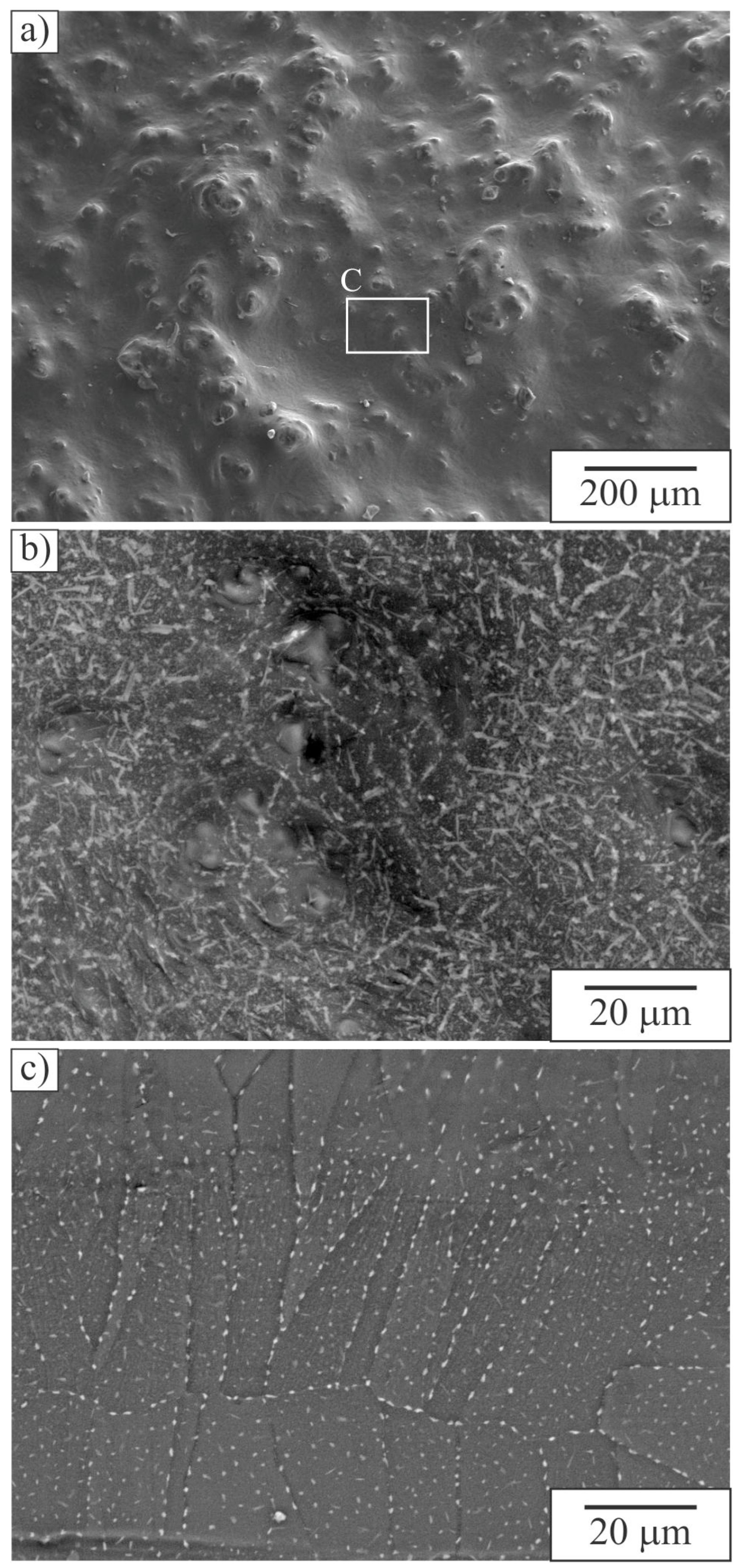

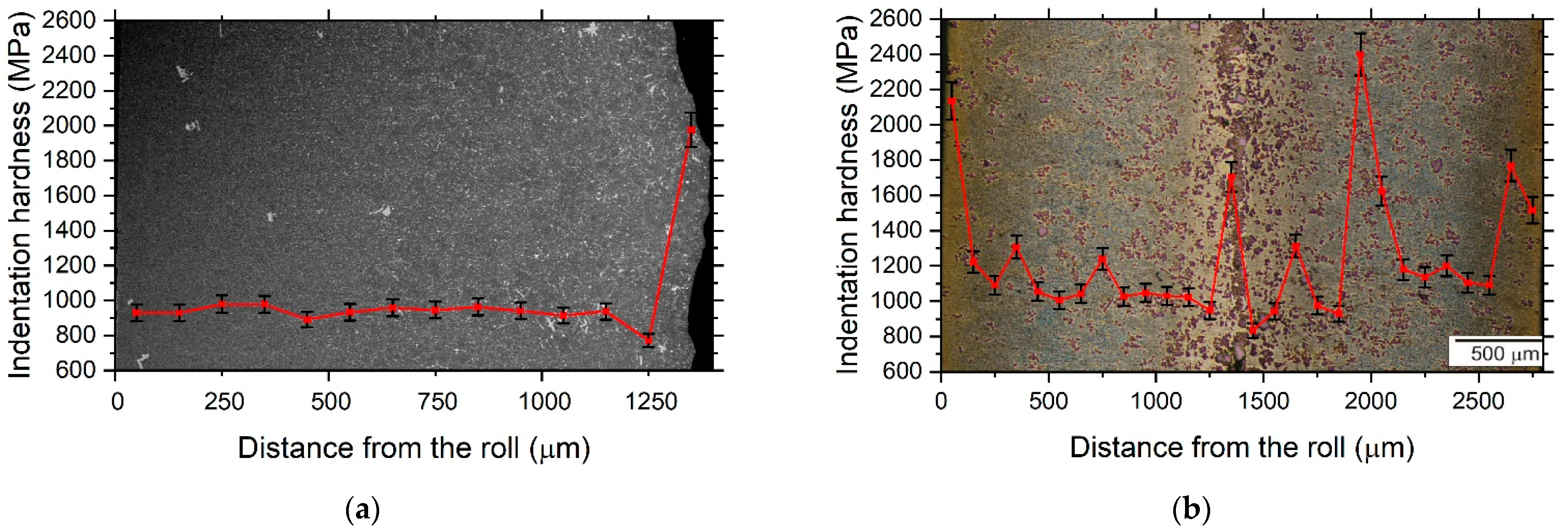

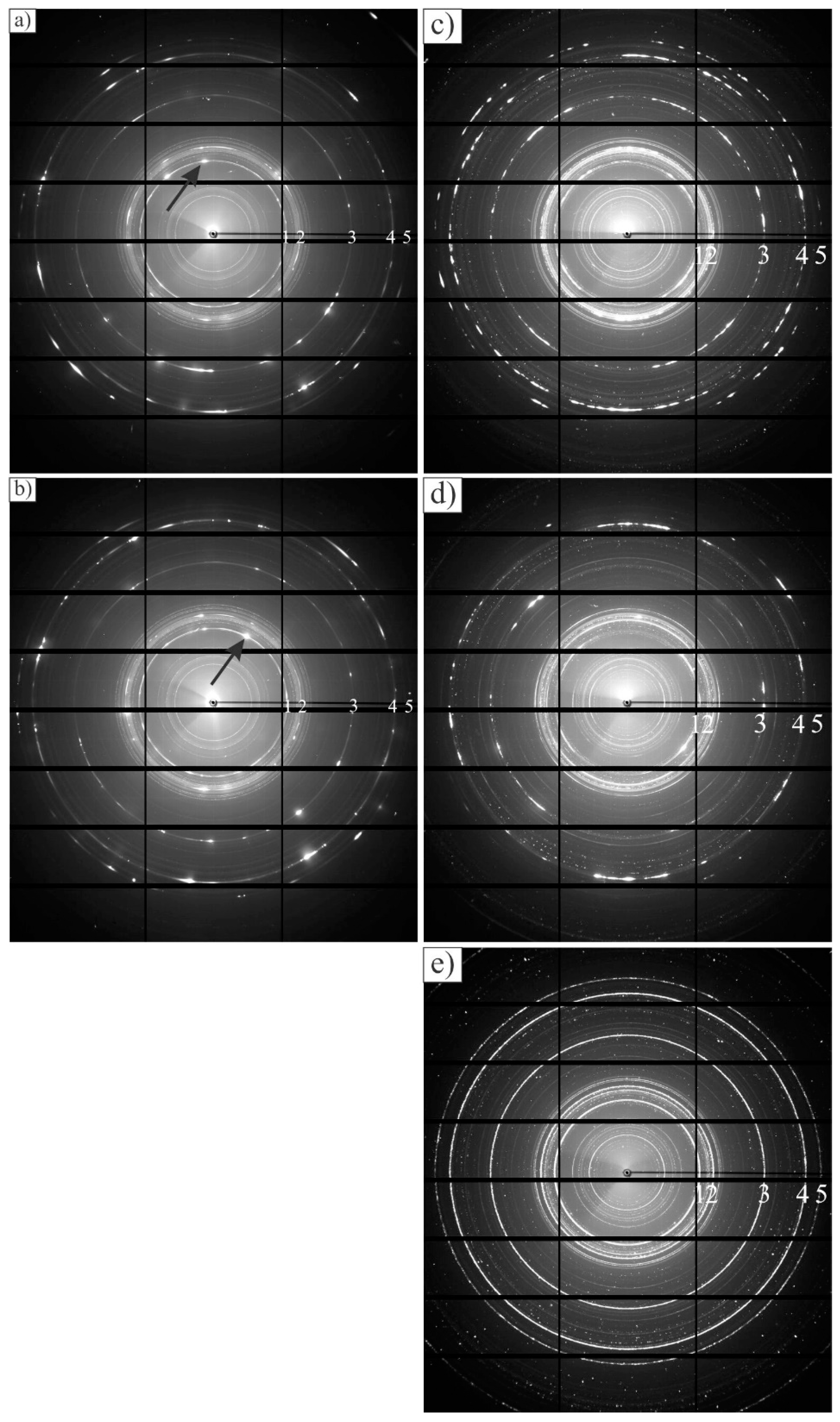
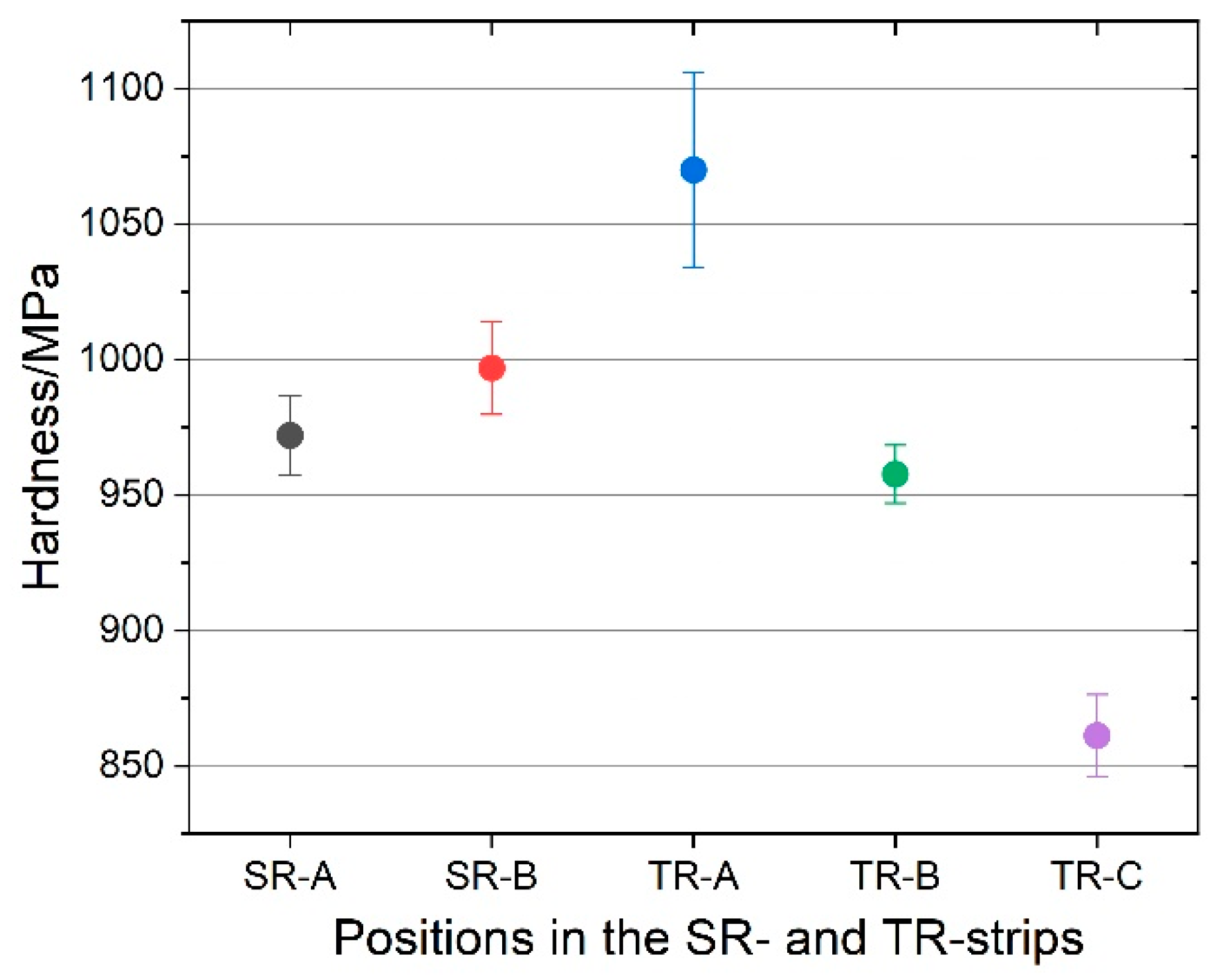
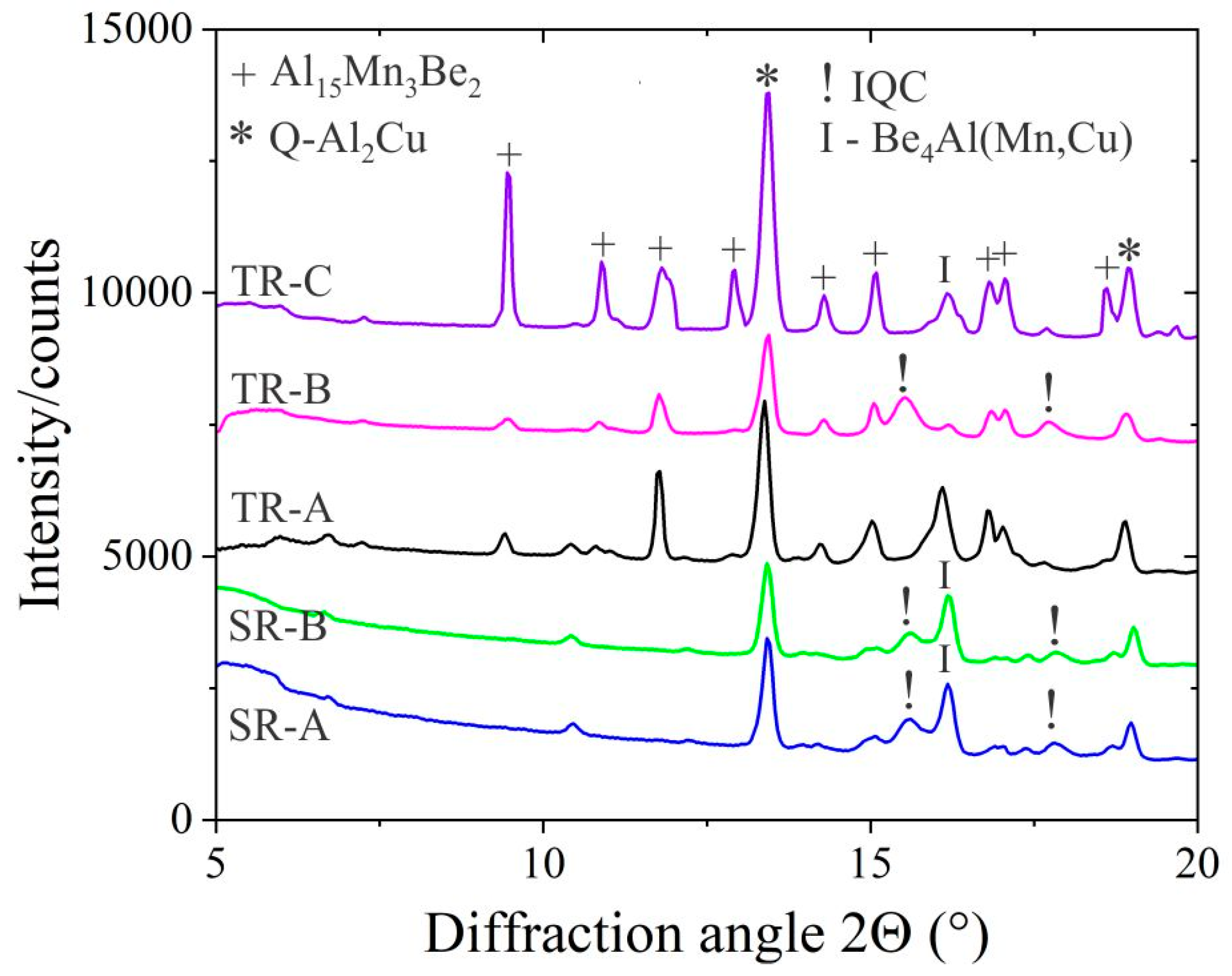
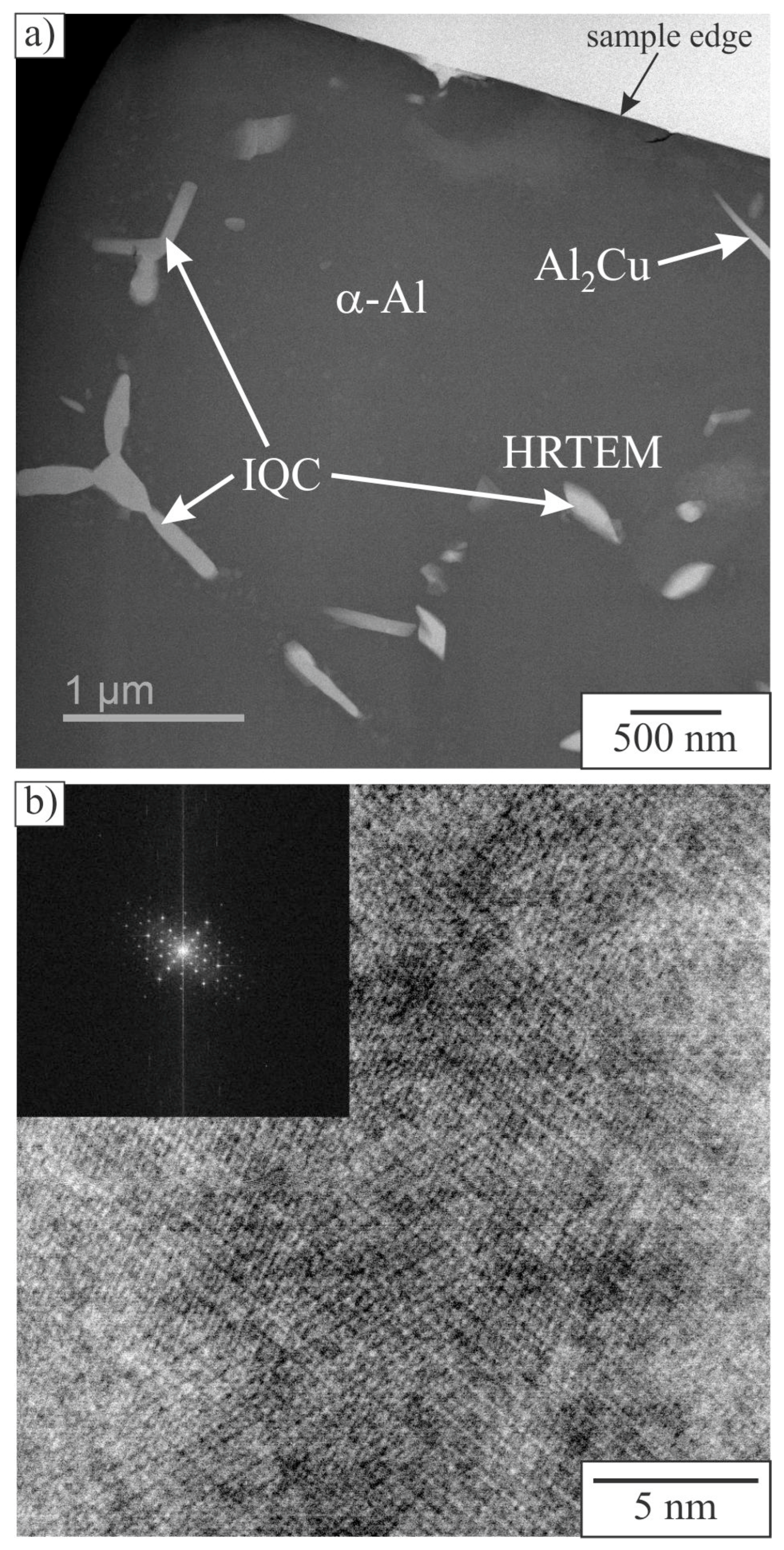
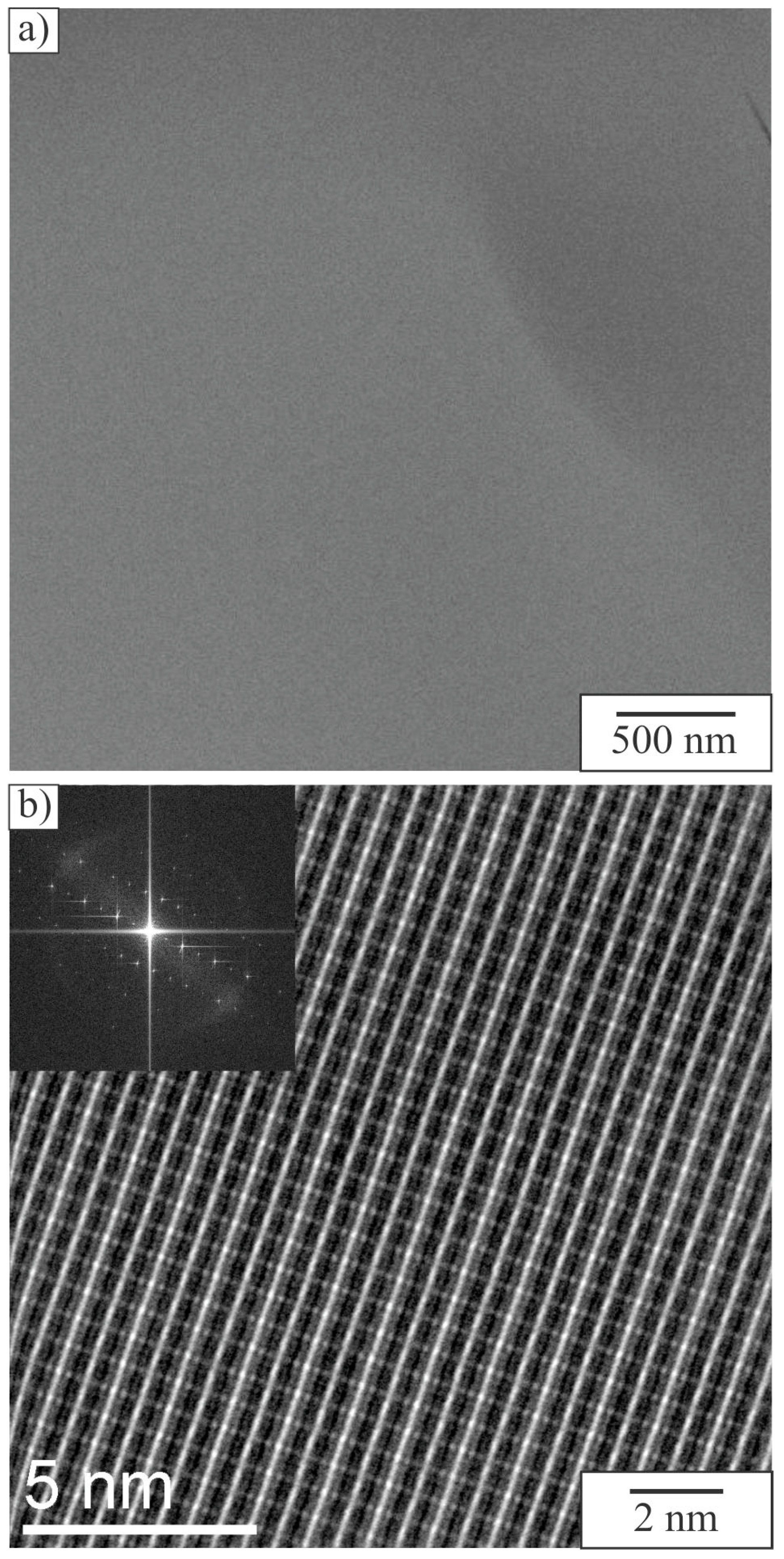
| Element | Wt.% | At.% |
|---|---|---|
| Mn | 4.21 | 2.14 |
| Cu | 4.26 | 1.87 |
| Be | 0.696 | 2.15 |
| Si | 0.02 | 0.02 |
| Fe | 0.03 | 0.02 |
| Al | Remaining | Remaining |
| Phase | Al | Mn | Cu |
|---|---|---|---|
| α-Al | 98.1 ± 0.7 | 0.9 ± 0.3 | 1.0 ± 0.3 |
| Be4Al (Mn, Cu) | 58.2 ± 1.5 | 38.7 ± 0.7 | 3.1 ± 0.4 |
| Al15Mn3Be2 | 79.0 ± 1.2 | 19.4 ± 0.6 | 1.6 ± 0.2 |
| Al2Cu | 68.7 ± 1.1 | - | 31.3 ± 0.7 |
| IQC | 74.6 ± 3.1 | 14.9 ± 0.9 | 10.5 ± 2.5 |
Publisher’s Note: MDPI stays neutral with regard to jurisdictional claims in published maps and institutional affiliations. |
© 2022 by the authors. Licensee MDPI, Basel, Switzerland. This article is an open access article distributed under the terms and conditions of the Creative Commons Attribution (CC BY) license (https://creativecommons.org/licenses/by/4.0/).
Share and Cite
Zupanič, F.; Macerl, M.; Haga, T.; Bončina, T. Microstructure and Indentation Properties of Single-Roll and Twin-Roll Casting of a Quasicrystal-Forming Al-Mn-Cu-Be Alloy. Metals 2022, 12, 187. https://doi.org/10.3390/met12020187
Zupanič F, Macerl M, Haga T, Bončina T. Microstructure and Indentation Properties of Single-Roll and Twin-Roll Casting of a Quasicrystal-Forming Al-Mn-Cu-Be Alloy. Metals. 2022; 12(2):187. https://doi.org/10.3390/met12020187
Chicago/Turabian StyleZupanič, Franc, Matjaž Macerl, Toshio Haga, and Tonica Bončina. 2022. "Microstructure and Indentation Properties of Single-Roll and Twin-Roll Casting of a Quasicrystal-Forming Al-Mn-Cu-Be Alloy" Metals 12, no. 2: 187. https://doi.org/10.3390/met12020187






